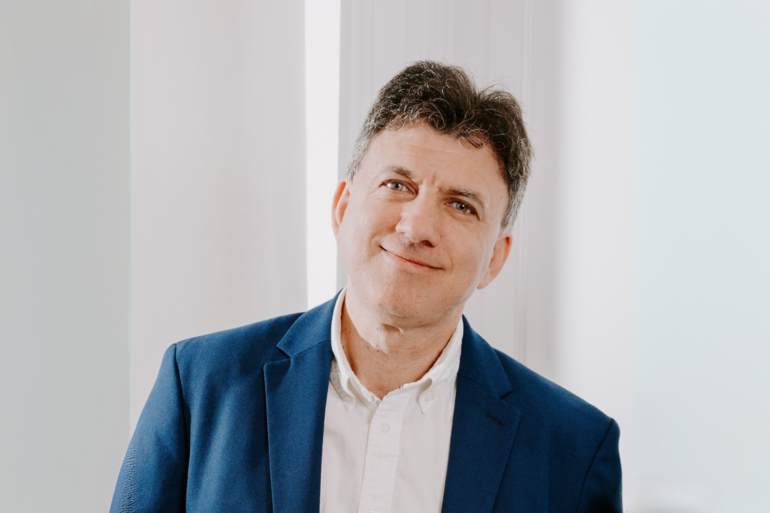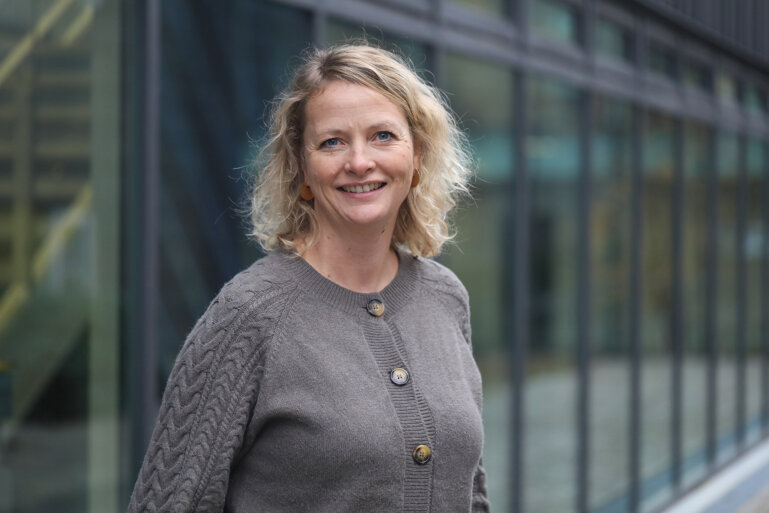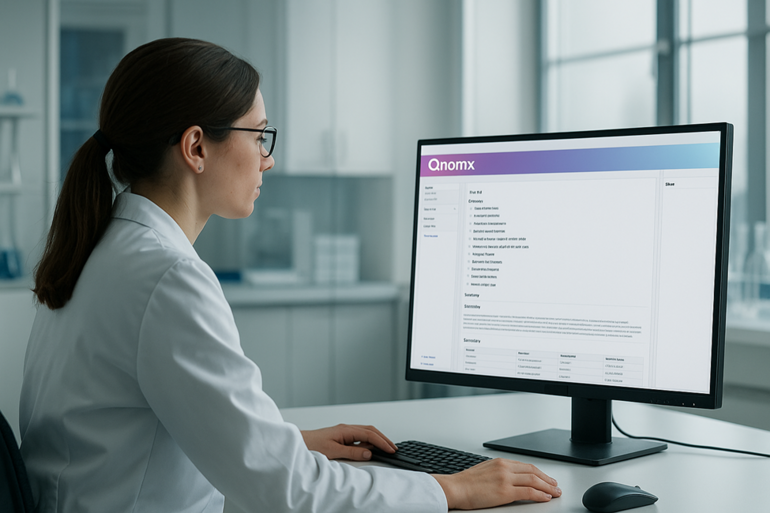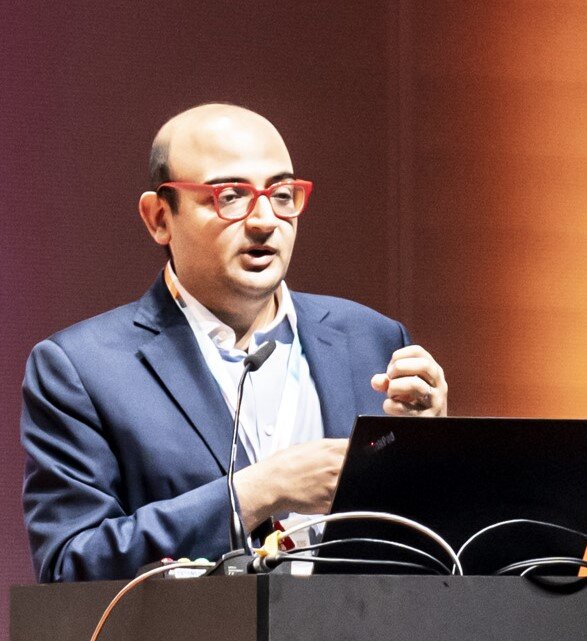ESMO now welcomes members from other disciplines to support and expedite the digital transformation of cancer care
Oncology is becoming an increasingly interdisciplinary field where artificial intelligence (AI) plays a critical role. Collaboration across domains is no longer optional, and in this rapidly evolving landscape every professional has to find their role. Fostering a more collaborative and inclusive approach in cancer research, which thrives at the intersection of science, technology, and medicine, ESMO has recently started to welcome professionals from diverse fields. One of them is Nikos Paragios, professor of applied mathematics at the school of engineering (CentraleSupelec) of the Paris-Saclay University, France, and founder, president and CEO of TheraPanacea, a medical technology company created in 2017 developing AI solutions for precision medicine.
What made you develop a specific interest in oncology?
From the very beginning of my academic career in the late 90s, I was interested in the use of mathematics and computer science in healthcare, not only in oncology, as I have always believed that data scientists can support medical professionals in their everyday activities. Then, around a decade ago, personal situations gave me extra motivation to invest in the field. When I lost both my aunt and my uncle from cancer within a short period, I came close to seeing how patients are treated, realising that treatments may be ineffective and can have side-effects. That experience made it clearer to me that it is not easy to make clinical decisions in oncology, specifically because the disease is associated with large volumes of multimodal data which human beings are still not able to understand.
What does it mean for a data science professional to be a member of a medical oncology society like ESMO?
Complementing clinical knowledge with data-driven analytics may help improve how people with cancer are treated, so building interdisciplinary expert networks is important. We need to demonstrate that each discipline brings unique value to the table: this is what motivated me to get involved with ESMO.
Today, we live in a sort of “overhype” era: scientists tend to make bold promises about what will happen, but in many cases, those outcomes are still far off.
So, I think we, as scientists, share responsibility for some skepticism that historically oncologists and other physicians had toward us. If I go to a physician and say, “Give me your data, and I will solve your problems,” but then fail to deliver because the problems in oncology are extremely complex, trust is lost. This is why we need to manage expectations carefully.
The real question now is: how can we transform this current phase of excitement shared by oncologists, mathematicians, scientists, and engineers into something that brings real value to patients with cancer? We can write papers or secure excellent research grants, but at the end of the day, as a community, we must be able to say that technology is truly helping someone. And often, the biggest impact does not come from the most advanced mathematics or the most exciting scientific breakthroughs, but from solving practical problems that clinicians actually face and need help with.
Fortunately, I think the scenario is changing. Today, there is growing and genuine appreciation among oncologists for what data, machine learning, and AI can offer. But we must remain vigilant and progress step by step towards using these tools first to standardise care and then eventually to improve practices, outcomes and personalise treatments. This will ensure that the promise does not turn into hype and ultimately, disillusionment.
One of the oncology areas you focus on in your research is radiotherapy. How is AI changing the field?
Radiotherapy is one of the most underestimated treatment options in oncology. It is used a lot, and it brings clear benefits to many patients with cancer, but its efficacy is often overlooked compared to other treatment types. This specific field lacks standardisation automation, meaning that many tasks are performed manually by physicians with great discrepancies in outcomes even within the same centers or teams, while being tedious and very time-consuming.
AI and machine learning offer the opportunity to collect data from medical centers with the highest expertise, and importantly from patients who experienced the best outcomes, and use them to train algorithms that could potentially replicate best-in-class treatment strategies, making them available not only at elite institutions but at hospitals and clinics everywhere.
Translating AI models from research to real-world clinical use is far from being simple, and a significant gap exists between what works on paper and what succeeds in practice. How to overcome this issue?
When my research team and I started working on medical imaging and its application in radiotherapy, some papers had already been published in international peer-reviewed journals leading us to think that their quality would have supported our efforts to translate findings from the laboratory to the clinical setting. However, this was not the case, and we realised that published clinical research usually reports on positive outcomes only which come from very small datasets, so may not be representative of the clinical reality in terms not only of disease manifestations, but also medical expertise and infrastructures.
It is essential to form partnerships with multiple hospitals to collect diverse data and involve highly qualified scientific personnel to ensure that the datasets used for both training and testing are the right ones. Also, when you are trying to build something that will be used at scale, you must consider that different centres have different machines, use varying practices, and generate data of mixed quality. Critical aspects such as sample distribution, data quality, and testing procedures must be addressed upfront at the study design phase, and continuous performance monitoring of the deployed solution is also essential for the success of a technology. Ultimately, technology also plays a crucial role. Every problem is unique from a scientific perspective, so choosing the right tools is equally important. Transitioning from a technology prototype to a system or tool that can be integrated into clinical workflows is a substantial leap. If your technology does not accurately reflect the clinical environment, it will never be viable for real-world use.
TheraPanacea is a compound noun derived from two ancient Greek words: Therapeía (therapy) and Panakeía (the universal remedy for all diseases). To what extent does this name reflect the potential of AI in oncology?
The name reflects our ambition that AI may become a shared approach to address current discrepancies in cancer care across different countries where education, expertise, and resource availability and allocation may differ. By providing scalable solutions, it helps disseminate best practices, which remains the primary application of AI-driven systems and tools today.
At some point, AI will begin to transform the treatment paradigm, supporting oncologists in going beyond current practices and challenges. This includes a better understanding of tumour phenotyping by integrating multiple data sources such as imaging, genomic, and clinical data which could lead to effective treatment personalisation. However, it will take time before AI reaches its full potential in healthcare.
Although the human brain is far more powerful than AI in many ways, it operates based on specific functional modalities. For example, if you present humans with a 5-by-5 matrix of values, they are unlikely to identify correlations within it because our brain is not designed to process structured data. In contrast, computers excel at identifying patterns in such data through repeated calculations. AI algorithms are not inherently smarter than humans: they simply perform tasks in fundamentally different ways at a scale that we cannot.
AI & Digital Oncology: Resources in one place
Looking for further insights into how artificial intelligence and digital tools are impacting oncology? The ESMO AI & Digital Oncology Hub brings together expert perspectives, research updates, and thought leadership from across oncology.
It is a space where you can stay informed, discover resources, and follow the conversation on digital innovation in cancer research and treatment.
To further explore the transformative potential of AI in oncology, the very first ESMO AI and Digital Oncology Congress 2025, taking place from 12 to 14 November, will provide a dedicated platform focused on the latest advances in AI and digital technologies in cancer care.







